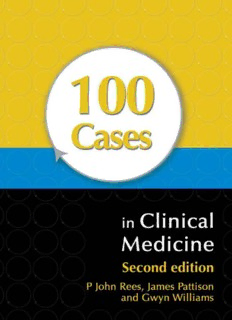
100 Cases in Clinical Medicine PDF
Preview 100 Cases in Clinical Medicine
100 CASES in Clinical Medicine 100 CASES in Clinical Medicine Second edition P John Rees MD FRCP Consultant Physician and Professor of Medical Education, King’s College London School of Medicine at Guy’s, King’s and St Thomas’ Hospitals, London, UK James Pattison DM FRCP Consultant Nephrologist, Guy’s and St Thomas’ NHS Foundation Trust, London, UK Gwyn Williams MD FRCP Emeritus Professor of Medicine, King’s College London School of Medicine at Guy’s, King’s and St Thomas’ Hospitals, London, UK First published in Great Britain in 2000 by Arnold This second edition published in 2007 by Hodder Arnold, an imprint of Hodder Education and a member of the Hodder Headline Group, 338 Euston Road, London NW1 3BH http://www.hoddereducation.com Distributed in the United States of America by Oxford University Press Inc., 198 Madison Avenue, New York, NY10016 Oxford is a registered trademark of Oxford University Press © 2007 P John Rees, James M Pattison and Gwyn Williams All rights reserved. No part of this publication may be reproduced or transmitted in any form or by any means, electronically or mechanically, including photocopying, recording or any information storage or retrieval system, without either prior permission in writing from the publisher or a licence permitting restricted copying. In the United Kingdom such licences are issued by the Copyright Licensing Agency: Saffron House, 6-10 Kirby Street, London EC1N 8TS. Whilst the advice and information in this book are believed to be true and accurate at the date of going to press, neither the authors nor the publisher can accept any legal responsibility or liability for any errors or omissions that may be made. In particular (but without limiting the generality of the preceding disclaimer) every effort has been made to check drug dosage; however it is still possible that errors have been missed. Furthermore, dosage schedules are constantly being revised and new side-effects recognized. For these reasons the reader is strongly urged to consult the drug companies’ printed instructions before administering any of the drugs recommended in this book. Hodder Headline’s policy is to use papers that are natural, renewable and recyclable and made from wood grown in sustainable forests. The logging and manufacturing processes are expected to conform to the environmental regulations of the country of origin. British Library Cataloguing in Publication Data A catalogue record for this book is available from the British Library Library of Congress Cataloging-in- Publication Data A catalog record for this book is available from the Library of Congress ISBN-10 0 340 92659 7 ISBN-13 978 0 340 92659 8 Commissioning Editor: Fiona Goodgame Project Editor: Jane Tod Production Controller: Lindsay Smith Cover Designer: Laura de Grasse Indexer: Laurence Errington Typeset in 10/12 RotisSerif by Charon Tec Ltd (A MacMillan Company), Chennai, India www.charontec.com Printed and bound in Spain What do you think about this book? Or any other Hodder Arnold title? Please visit our website at www.hoddereducation.com CONTENTS Preface vii Acknowledgements ix Abbreviations xi Section 1: Systems-related cases 1 Cardiology 3 Respiratory 9 Abdomen 14 Liver 19 Renal 23 Endocrinology 27 Neurology 33 Rheumatology 37 Haematology 43 Infection 47 Section 2: General self-assessment cases 53 Index 257 This page intentionally left blank PREFACE Most doctors think that the most memorable way to learn medicine is to see patients. It is easier to recall information based on a real person than a page in a textbook. Another important element in the retention of information is the depth of learning. Learning that seeks to understand problems is more likely to be accessible later than superficial factual accumulation. This is the basis of problem-based learning, where students explore prob- lems with the help of a facilitator. The cases in this book are designed to provide another useful approach, parallel to seeing patients and giving an opportunity for self-directed exploration of clinical problems. They are based on the findings of history taking and examination, together with the need to evaluate initial investigations such as blood inves- tigations, X-rays and ECGs. These cases are no substitute for clinical experience with real patients, but they provide a safe environment for students to explore clinical problems and their own approach to diagnosis and management. Most are common problems that might present to a general practitioner’s surgery, a medical outpatients or a session on call in hospital. There are a few more unusual cases to illustrate specific points and to emphasize that rare things do present, even if they are uncommon. The cases are written to try to interest students in clinical problems and to enthuse them to find out more. They try to explore thinking about diagnosis and management of real clinical situations. The first 20 cases are arranged by systems, but the next 80 are in random order since, in medicine, symptoms such as breathlessness and pain may relate to many different clinical problems in various systems. We hope you enjoy working through the problems presented here and can put the lessons you learn into practice in your student and subsequent career. P John Rees James Pattison Gwyn Williams January 2007 This page intentionally left blank ACKNOWLEDGEMENTS The authors would like to thank the following people for their help with illustrations: Dr A Saunders, Dr S Rankin, Dr J Reidy, Dr J Bingham, Dr L Macdonald, Dr G Cook, Dr T Gibson, Professor R Reznak, Dr B Lams, Dr J Chambers, Dr H Milburn and Dr J Gilmore. This page intentionally left blank
